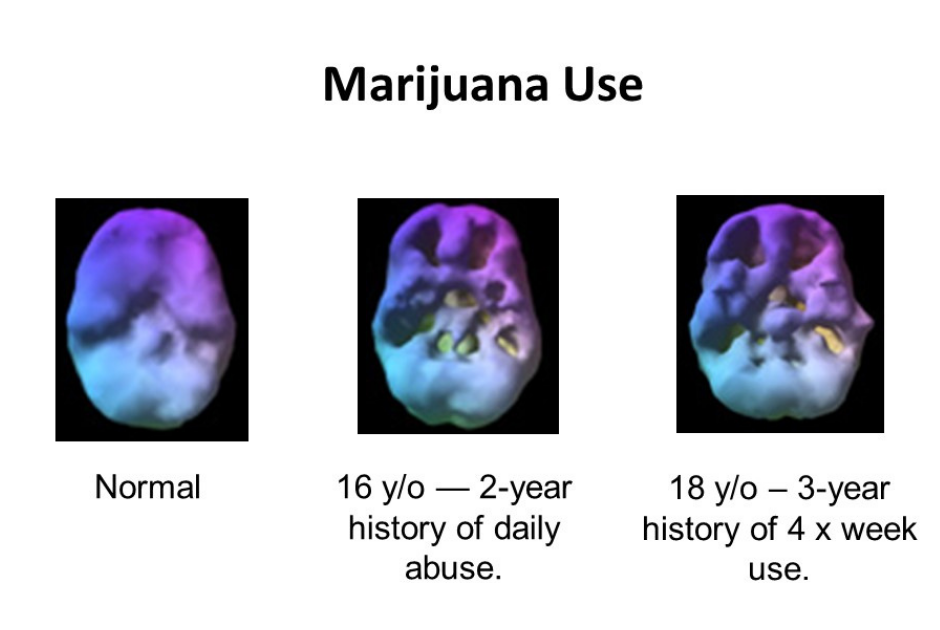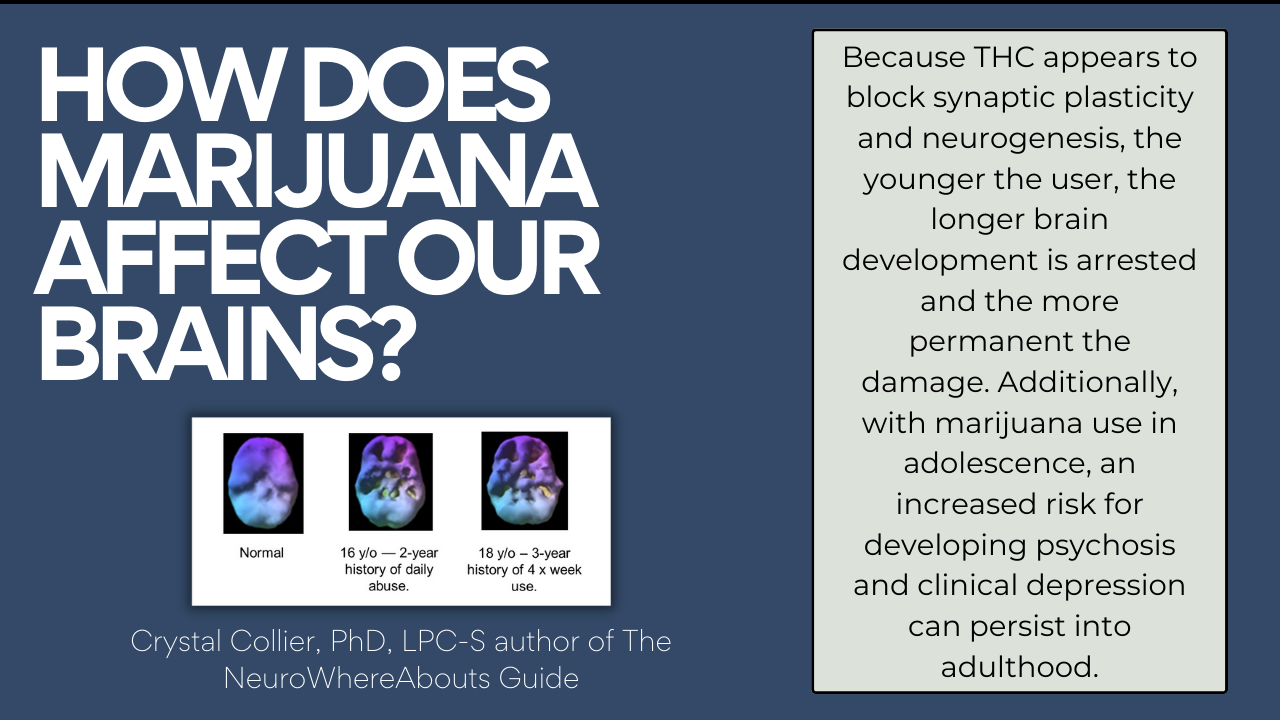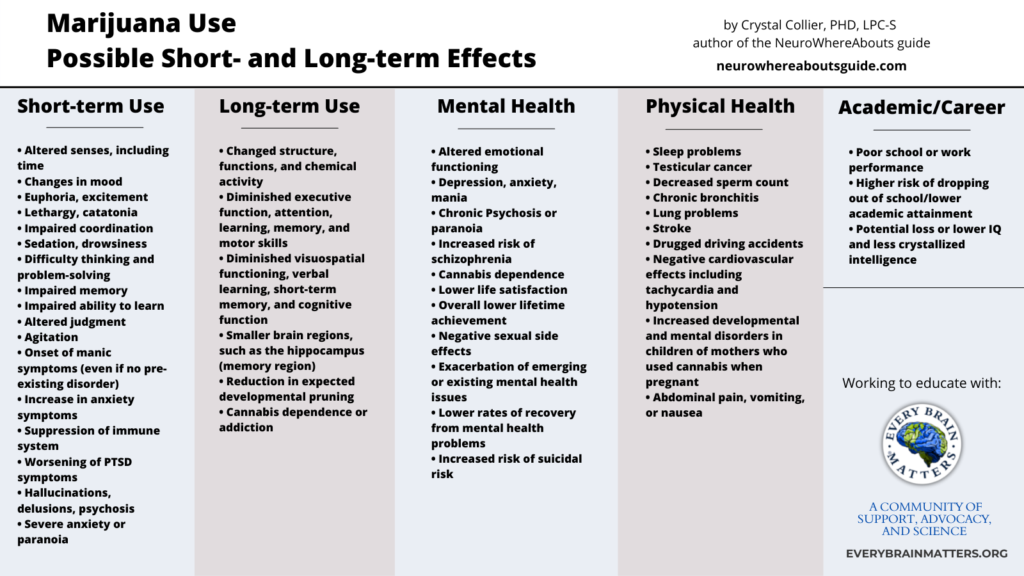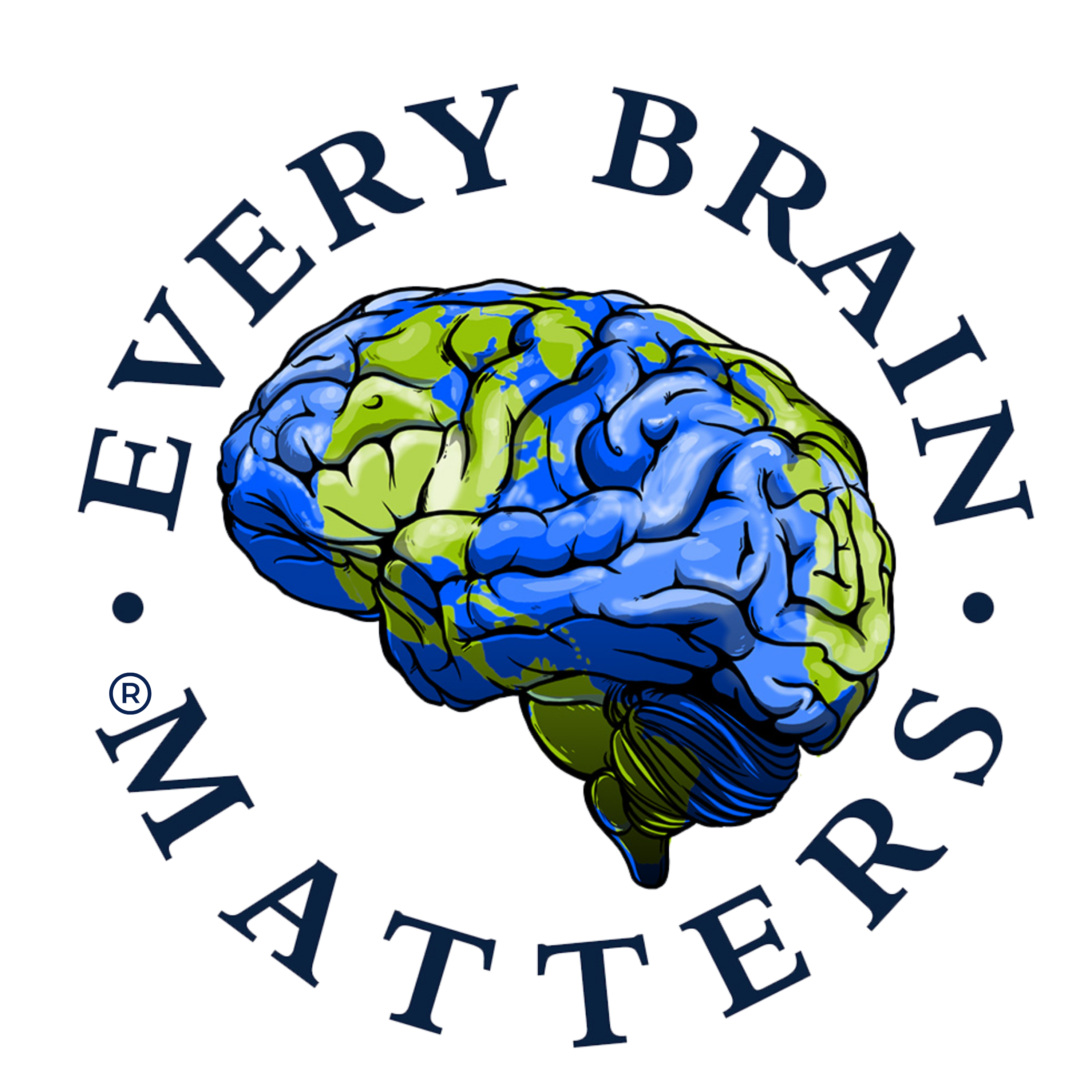Posted on January 9, 2022 View all news
by Crystal Collier, PhD, LPC-S author of The NeuroWhereAbouts Guide and creator of BrainAbouts
There is a prevailing opinion in our community today that marijuana is a good and safe choice for treating a multitude of emotional and physical problems in youth and adults. But what are the facts? How does marijuana affect the brain?
How It Works, Naturally
Our brain makes chemicals that send messages throughout our body. These messages tell our brain and body what it needs for survival and health maintenance. Most everyone has heard about one of these chemicals, dopamine, which increases the calm and happy feelings we get after eating, connecting with loved ones, or while using mood-altering substances. But not everyone knows about anandamide, dopamine’s less potent cousin.
Anandamide got its name from an old Sanskrit word Ananda, which means joy, bliss, and delight. True to this meaning, anandamide plays a role in regulating eating and sleeping patterns and in pain relief. This chemical binds to receptor sites in the human body’s endocannabinoid system, a system that is involved in regulating a long list of processes including pleasure, memory, thinking, concentration, movement, coordination, and sensory and time perception.
Anandamide’s job is to help make sure all these systems are working well and staying in balance. Then, along comes tetrahydrocannabinol or THC for short. THC is a compound that looks almost exactly like anandamide and because THC’s molecular structure is almost identical, it binds to the same cannabinoid receptors normally occupied by anandamide.
Hijacked by the Imposter
The endocannabinoid system oversees pain relief in addition to regulating appetite, mood, and memory. When the psychoactive chemical found in marijuana, THC (tetrahydrocannabinol), binds to the receptor sites in the endocannabinoid system, a more intense effect is produced than the one from the body’s natural pain-regulating chemical, anandamide. One might think a more intense relief of pain is a good thing. In fact, there are possible pain and inflammation reduction uses for cannabis and other compounds like THC’s non-psychoactive sister, CBD (cannabidiol) currently being studied.
However, anandamide’s imposter, THC, poses problems. It can overload the endocannabinoid system, interfering with the body’s natural ability to regulate and relieve pain. Ironically, this may result in increased pain, sleep problems, depression, or anxiety; the very impetus for use in the first place.
Moreover, THC is psychoactive, which means it changes a person’s mental state and the way the nervous system works. This can lead to intoxication, tolerance, withdrawals, and dependence. THC compounds are also neurotoxic to brain development by way of shutting down the front lobe while it is growing. And because THC loves to accumulate in fat, it gets stored there for long periods of time, potentially arresting neurodevelopment longer than other substances that leave the body faster.
Although the user may prefer the euphoria that occurs when anandamide is bumped out and replaced by THC, the more intense effect from this imposter wreaks havoc on endocannabinoid systems, including appetite, mood, motor function, and memory. These effects may cause cannabis toxicity, hyperemesis syndrome (severe nausea and vomiting), or psychosis (a break from reality). Eventually, the user’s brain may produce less anandamide as the body begins to prefer or become dependent on the imposter, THC, resulting in cannabis use disorder. See the definitions below for more information.
Critical Lesson: Negative Effects are Greater in Youth
The lists below contain the results of longitudinal research conducted over the past 30 years revealing the harmful physical and psychosocial effects marijuana can have, especially on youth. Marijuana or other cannabis product use is associated with brain structure/size differences and alterations in neurodevelopment.

There is also executive function impairment in multiple areas, including:
- Processing speed
- Attention
- Memory
- Learning
- Impulse control
- Decision-making
- IQ
- Visuospatial skills
These impairments may sometimes be short-term, but not always. They sometimes persist even after marijuana use is stopped, especially for heavy users and/or users who started using at a young age. Such longer-lasting problems can be less evident in adults who began using cannabis later in life. The good news is that impairments caused by regular use are often reversible after sustained abstinence.
Because THC appears to block synaptic plasticity and neurogenesis, the younger the user, the longer brain development is arrested and the more permanent the damage. Additionally, with marijuana use in adolescence, an increased risk for developing psychosis and clinical depression can persist into adulthood.
Prevention or “rite of passage” for youth?
For many adults, occasional low-concentrated marijuana may have less severe effects, but some may exhibit psychosis, have a toxic reaction, suffer a drugged driving accident, and 10-17% may become dependent or addicted. And we don’t know if high concentrated marijuana products (products that contain 10 mg or more) are safe for adults to use.
What we do know is that for youth under the age of 25, marijuana use has negative effects on the developing brain. So, ‘brain-savvy’ parents have scientific justification for saying “No!’” to their children when it comes to marijuana.
Prevention is key to healthy frontal lobe/brain development. If marijuana use is discovered, seek qualified therapeutic assistance from a professional who works with youth, or adults who engage in substance use.
DEFINITIONS
ENDOCANNABINOID SYSTEM —A biological system of neurotransmitters and receptors that helps regulate appetite, pain sensation, mood, and memory.
ANANDAMIDE —A cannabinoid or neurotransmitter produced by the body in the Endocannabinoid System that regulates pleasure, memory, thinking, concentration, movement, coordination, and sensory and time perception.
THC or delta-9 TETRAHYDROCANNABINOL —One of 60 cannabinoids found in the Cannabis sativa plant that binds to the same receptor sites as natural anandamide, but with greater intensity. It is marijuana’s primary psychoactive substance, causing intoxication and dependence (addiction).
CBD or CANNABIDIOL— One of 60 cannabinoids found in the Cannabis sativa plant. It reduces pain and swelling. It does not cause euphoria, intoxication, or dependence (addiction) like THC does. Although CBD’s action in the brain is not totally understood, research indicates it may be effective for seizure disorders and other medical and psychiatric conditions.
CANNABIS USE DISORDER — Marijuana addiction characterized by compulsive use, loss of control in limiting use, and the emergence of a negative emotional and physical state when in withdrawal with continued use despite distress or consequences
CANNABIS TOXICITY — Caused by ingesting too much marijuana, resulting in impaired coordination, drooling, vomiting, lethargy, depression, seizures, coma or hyperactivity and agitation.
CANNABIS HYPEREMESIS SYNDROME — Frequent, cyclic, severe nausea and vomiting accompanied by dehydration and abdominal pain caused by cannabis use.
CANNABIS-INDUCED PSYCHOSIS — Sudden onset of mood lability and paranoid symptoms, within 1 week of cannabis use but as early as 24 hours after use. Symptoms may also include grandiosity, perceptual alterations, severe anxiety, and cognitive deficits in working memory, verbal recall, and attention.
Cannabis Withdrawal Symptoms
- Grouchiness, irritability, anger, or aggression
- Social withdrawal
- Depression
- Sleep problems (insomnia or disturbing dreams)
- Appetite changes (decreased appetite or weight loss)
- Anxiety or nervousness
- Restlessness
- Cravings
- Loss of motivation
- Stomach pain, shakiness, sweating, fever, chills, headache
- Symptoms begin 1-2 days after last use
- Symptoms last between 7 and 30 days


